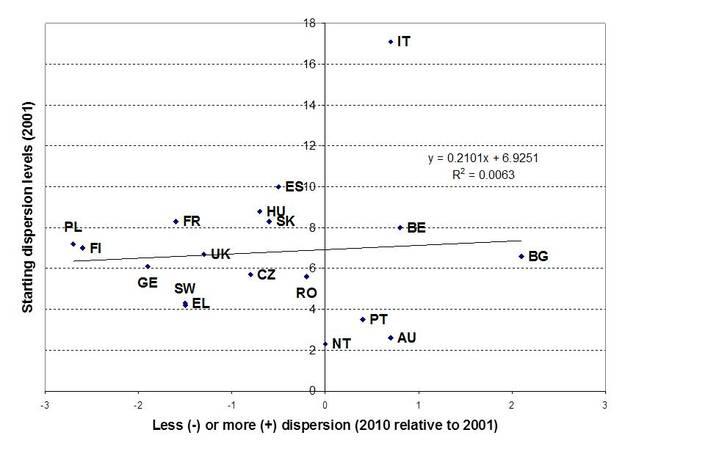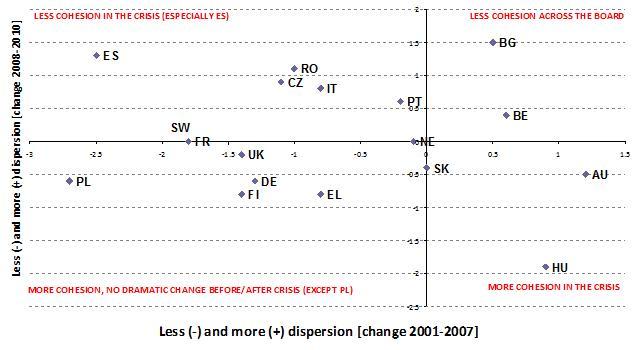Chart of the Week - The EU cohesion record: how did the crisis contribute?
The EU is in the process of discussing the EU cohesion package for 2014-2020, the size of the total allocation, the allocation to individual member states and the working principles of the new cohesion policy. It is an important chapter for two reasons. First, there is still some way to go, as many EU countries still suffer from significant regional disparities. Second, the crisis has clearly worked against socio-economic cohesion, and this is more evident in some countries than in others.
1. The last decade
We look specifically at regional disparities in employment given the importance of labour markets and the fact that they have been strongly affected in the crisis. Chart 1 juxtaposes starting dispersion in regional employment in each country as of 2001 (vertical axis) and the change in the dispersion of regional employment from 2001 to 2010 (horizontal axis). Negative values on the horizontal axis point to less dispersion in regional employment, whilst positive values suggest rising disparities. A majority of EU member states managed to foster cohesion to some extent and probably for very diverse reasons considering that the two top performers, Poland and Finland, are very different from each other along numerous dimensions. But there are also countries where the cohesion record has actually deteriorated from 2001 to 2010. These include Bulgaria, Belgium, Austria, Italy and Portugal.
Furthermore, the poor correlation between the two variables is indicative of the fact that there has not been a proper convergence process meaning that internally diversified EU countries have not caught up over the last decade to become more homogeneous.
Chart 1: Regional disparities in employment (age group 15-64)

Source: author’s own elaboration based on Eurostat data.
2. The impact of the crisis on cohesion
One related question is the extent to which the recent crisis has contributed to regional disparities. Chart 2 is a scatter plot looking at the change in employment dispersion in the midst of the crisis from 2008 to 2010 (vertical axis) and in the pre-crisis period from 2001 to 2007 (horizontal axis). The general trend is towards an intensification of regional disparities during the crisis, which is both expected and worrying. But, as above, a closer look reveals quite a diversified picture. A few countries have indeed seen a dramatic deterioration in internal cohesion during the crisis compared with the previous period. These are Spain, which is top of the list, followed at some distance by Romania, the Czech Republic, Italy and Portugal. At the other extreme, however, Hungary and Austria have even improved internal cohesion during the crisis compared with the previous period. Others have generally posted a good record but the crisis has clearly interrupted the trend towards greater convergence, as evident on the example of Poland.
Groups of countries that have gone through a similar transformation are never a consistent category (euro area countries, Central and Eastern European countries or Southern European countries, etc.). This should be taken as an indication of the fact that there is probably not one single determinant of socio-economic cohesion and that many intervening factors contribute to the final result (eg. the asymmetric consequences from the crisis, the availability of EU funds, internal fiscal transfers, sheer luck or lack of, etc).
Chart 2: Regional disparities in employment (age group 15-64) before and after the crisis

Source: author’s own elaboration based on Eurostat data.